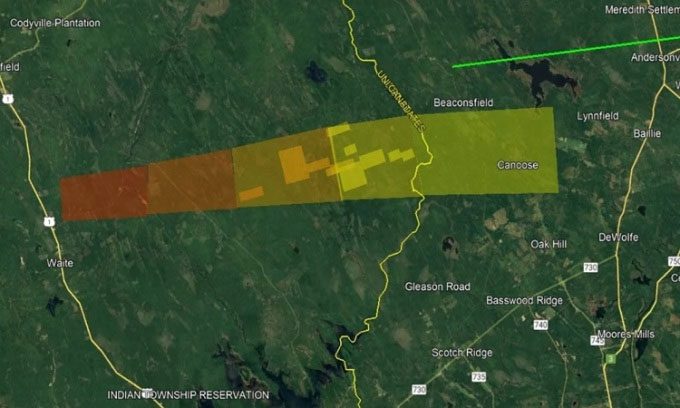A museum in Maine is willing to pay $25,000 for fragments of a meteorite that passed through the state last week and landed near the border between the United States and Canada.

The field believed to be where the meteorite fell, with fragments estimated to range from 10 kg (red) to 1 g (yellow) based on radar signals. (Photo: NASA)
An unusually bright fireball was clearly visible during the day as it flew across the sky on the afternoon of April 8, according to Darryl Pitt, head of the meteorite department at the Maine Mineral and Gem Museum in Bethel. According to NASA, the meteorite fall was observed using radar, and many witnesses reported hearing a sonic boom. The museum aims to add to its collection of Moon and Mars rocks, so meteorite hunters who can provide specimens weighing at least 1 kg will receive a reward of approximately $25,000, Phys.org reported on April 12. However, they will also pay for any specimens that correspond in size.
According to Pitt, the discovery of the meteorite fall helps ensure that meteorites can be found on the ground. The more people searching, the higher the chances of recovering meteorite fragments. However, there is no guarantee of finding a large enough piece to claim the reward. NASA stated that the estimated mass of meteorite fragments from radar signals primarily ranges from 1.59 to 322 grams, although larger fragments may fall to the ground.
Meteorite fragments will have a distinct shape compared to surrounding rocks. The exterior is likely darkened due to high temperatures during its descent through Earth’s atmosphere, while the interior may have a different color. It may also contain iron and be attracted to magnets. “Searching for meteorites in the forests of Maine is not a simple task. It is a sparsely populated area but not as desolate as places where most meteorites fall, which is the ocean,” Pitt said. Worldwide, only 8 to 10 meteorites are collected each year from hundreds recorded as having fallen to Earth.
Meteorite fragments may be scattered across land stretching from the town of Waite, Maine, to Canoose, New Brunswick. According to NASA, the largest specimens will likely be located at the western tip of the area, closest to Waite, which is about a 3.5-hour drive from Portland. Four radars detected signals matching the meteorite fall at the reported time and location.
The Maine Mineral and Gem Museum houses a large collection of specimens, including the largest intact Mars rock on Earth. The museum asks meteorite hunters to familiarize themselves with the object’s shape before searching to identify targets and avoid private properties unless granted permission by the homeowners.





















































